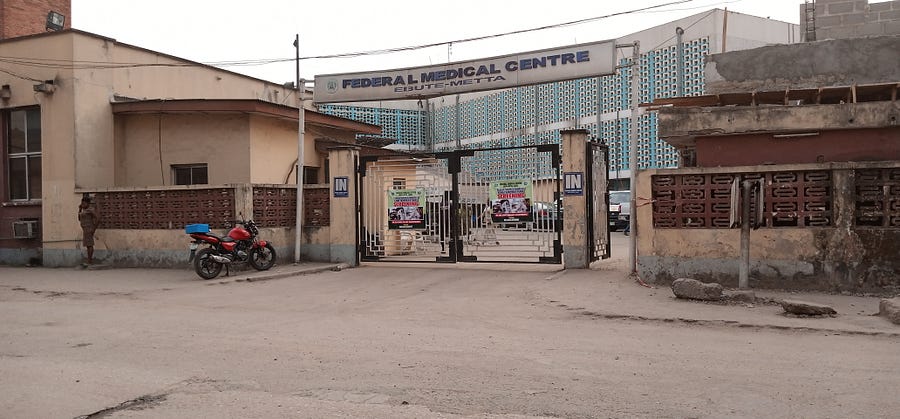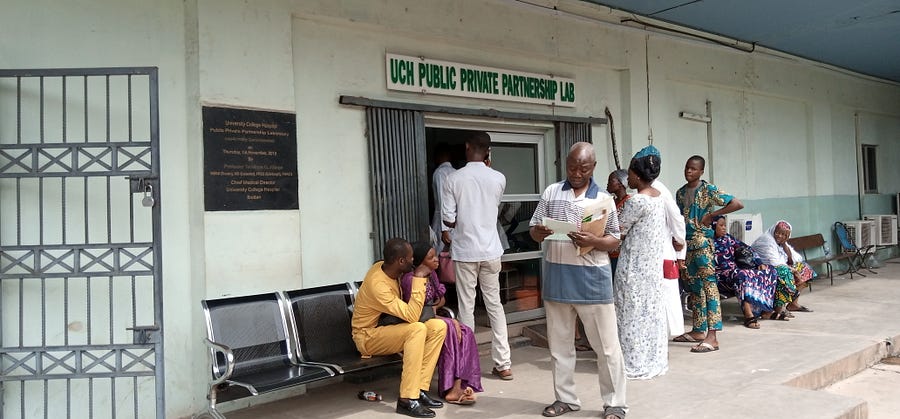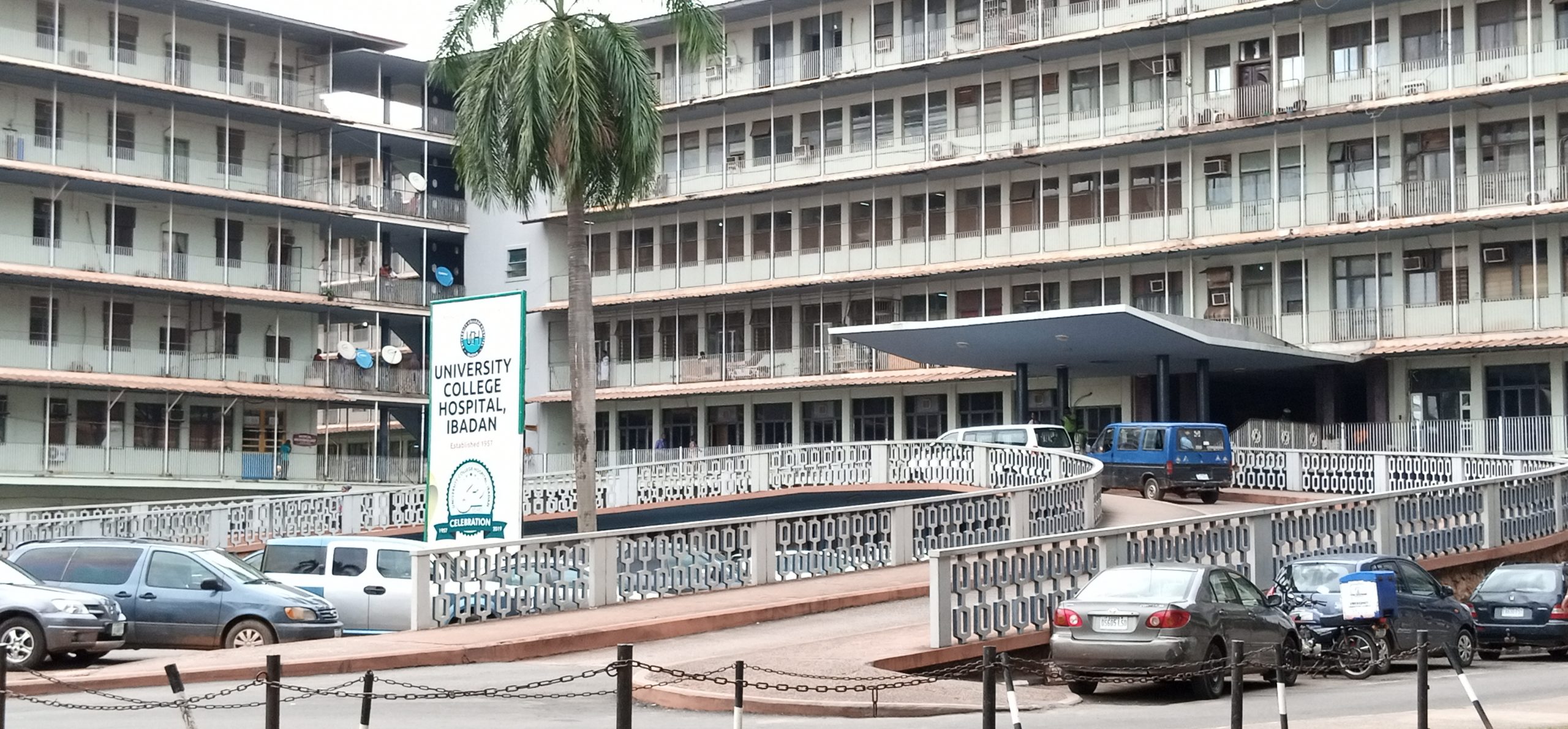By Taiwo Adebulu (Lead Writer)
“This article was produced in collaboration with Maternal Figures, a database of maternal health interventions implemented in Nigeria.”
Esther is pregnant and walked into the Radiodiagnostic centre at the Federal Medical Centre (FMC), Ebute Metta, Lagos State.
“Ultrasound?” one of the nurses asked as soon as she sat. She nodded in confirmation.
“You don’t need to sit. Come in,” the nurse replied, and ushered her into one of the rooms.
The radiology department is managed by Hospital Assist Nigeria (HAN), a private healthcare management firm that came into partnership with the hospital in October 2019 through a Public-Private Partnership (PPP) arrangement. According to Michael Adediran, HAN’s manager at the radiology centre, the facility is well equipped. Medical equipment available at the centre include 64-slice computed tomography (CT) scan machine, mammography mobile and static x-rays that are used to examine women in addition to providing ultrasound scans.
“We use the ultrasound to capture live images from the womb of a pregnant woman. It allows doctors to see problems with organs, vessels and tissues without needing to make an incision. We conduct fetal echocardiography to detect if a pregnant woman’s unborn baby may have congenital heart defects,” Adediran said.
In addition to providing ultrasound scans, the facility offers medical services like mammograms and emergency services speedily. “We offer an express service,” said Adediran.
Speaking on the PPP model, Adediran pointed out that HAN shares profits with the hospital.
“We brought in our staff and machines. Our staff makes up 30 percent and theirs is 70 percent. However, we manage the accounts and pay them 20 percent at the end of the month and we retain 80 percent of the revenue,” he said, adding that, “The centre runs 24 hours and the services are affordable, although a bit higher than public services. A CT scan at the radiology center is N15,000, an obstetric scan is N3,500 and a pelvic scan is N3,000. ”
Segun Daramola, who had brought his wife for a scan, said it was the second time he was using the facility.

“My wife’s friend referred us here because she used this place when she had a problem,” he said. “The other facility we used before coming here was overcrowded and the results took days. I can’t really wait that long. It’s quite fast here, although it is costing us more money. For me, I just want her to be okay.”
Poor Laboratory Facilities Contribute to Increased Maternal Death in Nigeria
Two months before the radiology centre was opened, the management of FMC Ebute-Metta began a PPP arrangement with Acouns Nigeria Limited to boost its laboratory services under the Reagent Rental Plan (RRP). In this partnership, Acouns brings in the equipment and maintains them, trains FMC Ebute-Metta staff to operate the equipment, while the hospital buys reagents.
According to Ekeghasi Obinna, a product specialist for Acouns, bacterial infection, premature birth complications, sepsis and other disorders are some of the causes of maternal death, which happen due to poor laboratory facilities.
“Due to poor laboratory facilities, it is very difficult to manage most of these situations. The diagnosis of sepsis, which may require a blood culture test, may take about 7 to 10 days for detection and thus may be too late to administer proper treatment when results are finally out,” Obinna said.
As a result of the diagnostic equipment available at the lab, Obinna notes that blood culture tests can now be completed within 72 hours.
“In general, the maternal and neonatal diagnosis has been made so easy, fast and reliable, thus ensuring that the best medical services are provided to them.”
Before the introduction of the two private partners in 2009, Olorunfemi Ayoola, FMC Ebute-Metta’s head of corporate communications, said the radiology and laboratory departments were not operating optimally.
“The roofs were leaking and the environment fell short of the standard. The equipment we had were not functioning well,” he said as he browsed through his laptop to show photos of deteriorating equipment at the wards.
“Now, the PPP guys have brought the modern equipment and technology we need to serve our patients,” he added.

Can PPPs Provide a Lasting Solution for Nigeria’s Health Sector?
According to the International Finance Corporation (IFC), many governments are turning to PPPs to provide healthcare services and infrastructure for their citizens. The agency noted that growing global demand for more and improved healthcare will require governments to tap the private sector for healthcare financing and delivery.
The long-term collaboration between government agencies and private-sector companies to fund public institutions has been proffered as a viable model to ensure better services and improve capacity to operate effectively. The PPP model is not new in Nigeria; it has been implemented in the aviation, electricity, transportation and education sectors. But its application in the health sector is still minimal.
The introduction of PPP into Nigerian healthcare was made possible through the National Policy on Public-Private Partnership for Health adopted by the Federal Government in 2005. The policy was introduced as a reform to address the deplorable national health profile as evidenced by poor infant and maternal mortality rates, and low life expectancy. The 2003 Nigeria Demographic Health Survey (NDHS) noted that the majority of births in Nigeria, 66 percent, occurred at home. Only one-third of live births during the five years preceding the survey occurred in a health facility. In 2005, the Federal Ministry of Health put the total number of formal health care facilities in Nigeria at 23,640, according to a 2016 report from African Population and Health Research Center.
Now, in addition to FMC Ebute-Metta, there are other hospitals with PPP arrangements across the country such as Garki Hospital, Abuja, Lagos University Teaching Hospital (LUTH), Ibom Specialist Hospital, Akwa Ibom, Lagos State University Teaching Hospital (LASUTH), and the University College Hospital (UCH), Ibadan, Oyo state to name a few.
According to the Infrastructure Concession Regulatory Commission (ICRC), a PPP-driven health care system will build an efficient healthcare ecosystem that will address the shortcomings of the public sector facilities and minimize outbound medical tourism. With this, the PPPs can focus on investing, building, operating, maintaining and replacing critically-needed hospital infrastructure.
In an interview with Chiedu Ndubisi, a former director at ICRC, he said the national assembly in 2005 passed the Infrastructure Concession Regulatory Commission Bill to empower the MDAs to use PPP as a vehicle for addressing the huge infrastructure deficit and help Nigeria attain, at the time, the Millennium Development Goals (MDGs).
“The private sector, both locally and internationally, has large pools of resources from which they can seek funding for which governments may not have access to, or the capacity to access,” Ndubisi said.
“Governments all over the world have come to recognize that the collaboration between public and private sectors is crucial to securing dependable and sustainable funding for infrastructure and reducing the pressure on fiscal budgets,” he added.
As things stand, the Nigerian health sector is battling with poor infrastructure, poor equipment, poor funding and low staff capacity. For 2020, the Federal Government allocated just 4.14% (N427.3 billion) of the budget to healthcare, despite being a signatory to the Abuja Declaration since 2001, where countries pledged to allocate at least 15% of their annual budget to improve the health sector. However, the senate has passed the revised 2020 budget, which witnessed a reduction in the budget cost as a result of the coronavirus pandemic and oil price plunge. Despite the reduction in the total budget, the health allocation was increased by N186 billion to cater for emergencies.

Meanwhile, the World Health Organisation (WHO) says nearly 20 percent of all global maternal deaths happen in Nigeria. “Between 2005 and 2015, it is estimated that over 600,000 maternal deaths and no less than 900,000 maternal near-miss cases occurred in the country. In fact, a Nigerian woman has a 1 in 22 lifetime risk of dying during pregnancy,” the WHO stated.
Not All Smooth Sailing: PPPs Have Challenges Too
Ayoola notes that while the PPP system is working, it did not come without challenges. “Introducing the PPP model by the management last year was not easy at all. We met stiff opposition from union members. You know some staff used to benefit from the system. Now, we are bringing in an efficient system that blocked all loopholes,” he said.
While the partnership is working well at UCH and FMC Ebute-Metta, it resulted in a long-term crisis at the Federal Medical Centre, Owerri, Imo State. In April 2015, Angela Uwakwem, then medical director of the hospital, made a proposal to introduce PPP into some services offered at the centre, but he was opposed by union members. The union accused the management of trying to set up the PPP arrangement as a way to divert public resources to private pockets. They maintained that PPP fuels corruption and only enriches private individuals at the expense of poor patients who need quality and affordable healthcare. This led to a protracted crisis and a series of protests resulting in the hospital being shut down for more than a year.

According to Chiedu Ndibisi, there is a hidden perception by some ministries, departments and agencies (MDA) personnel who misconstrue PPPs to mean loss of jobs or loss of relevance in the scheme of activities. This often results in subtle resistance to PPPs or poor implementation at best.
Another critique of the model is that despite the benefits PPPs offer, maternal health services like pelvimetry scans, fetal echocardiographs, and mammograms are still prohibitively expensive for the poor women in rural areas.
However, with the declining resource allocation to the health sector, more public hospitals are taking advantage of the National Policy on Public-Private Partnership for Health framework to collaborate with private entities to provide sustainable healthcare to those who need it the most.
Women like Esther deserve a safe pregnancy and childbirth. Public-Private Partnerships for health is an equitable way to ensure that this happens all over Nigeria.
“This article was produced in collaboration with Maternal Figures, a database of maternal health interventions implemented in Nigeria.”
Where else have you seen PPPs work effectively? Share with us on our social media platforms, @nighealthwatch on Twitter, and @nigeriahealthwatch on Facebook and Instagram.



Thanks a lot for this piece! This is one of the banes of my existence 🙂
Government alone cannot adequately fund and manage the provision of essential health services for all citizens in need, as we aspire for universal health coverage (UHC). Government should be deliberate about crowding-in the private sector to leverage the enormous resources available within that sector. Private sector can play a key role in bringing in the much needed additional finance, improved management expertise and practices and attracting back home our experts in diaspora. PPPs should be a strong strategy consideration for government in expanding access to care, especially for services that already have an established revenue flow and are bankable. PPPs also have a role even at the PHC level, if structured properly and linked to revenue-guaranteeing strategies such as health insurance.
PPP is the way to go for us in Nigeria. We must be sincere that majority don’t want it for selfish and myopic reasons. As soon as we prioritise public interest over personal gain we will move our situation esp health sector forward because we have the resources.